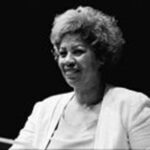The highly acclaimed narrative Beloved by African-American writer Toni Morrison takes place in Cincinnati, Ohio, from the 1850s to early 1970s. The story centers mainly on the novel’s protagonist, Sethe, and her journey in life, but also examines the lives of her two children, Denver and Beloved, and her close friend, Paul D. As the novel progresses, readers learn about their convoluted lives through a profound analysis of their past at the Sweet Home plantation in Kentucky. Morrison exposes the life of slavery and its impact on the African-American community. The method she uses is beautifully showcased through descriptive words, symbolism and unique literary devices in two of her most significant scenes in the novel.
One of the most noteworthy events is the birth of Sethe’s fourth and youngest child, Denver in the woods in Book One of Morrison’s novel. Sethe is about to give birth but at the same time, she is in agony. Her feet are swollen, knees are bleeding and her dress filled with “milk, sticky and sour” drew small creatures to her helpless body. Unexpectedly, Sethe receives aid from a benevolent white girl named Amy Denver whom she names her baby after. Initially, readers might hold an impression about Amy: a white individual who might abandon or turn in Sethe.
“‘Well he may as well come on. I can’t stand up let alone walk and Go help me miss, I can’t crawl.'”
“‘Sure you can you can, Lu. Come on,’ said Amy and, with a toss of hair enough for five heads, she moved toward the path” (34).
Amy, being a former indentured servant, is a sympathetic woman; she embarks on a journey to find colored velvet for her, after possibly suffering from mild adversity. Shortly, she eases Sethe’s pain. “Then she did the magic: lifted Sethe’s feet and legs and massaged them until she cried salt tears” (35). The scene illustrates a hopeful world where black-white relationships exist; there is anticipation that great change will take place. Here is Sethe, struggling to forget her past with the white folks but then, a white woman comes into her life and assists her; Sethe’s outlook on the white race slightly changes because of Amy. For this particular scene, Morrison uses symbolism in the form of a “chokecherry tree” etched in the back of Sethe. The trees are used frequently as a sign of hope and solace. After a life constantly facing pain and cruelty from the slave owners, hope is what Sethe sees in Amy. Morrison uses dialogue and descriptive language, in this scene, to provide readers a sense of what is happening, emotionally and mentally.
Another significant scene is when Paul D escapes from prison in Georgia. Readers see that Paul D’s most painful experience was at the prison.
“The wrists he held out for the bracelets that evening were steady as were the legs he stood on when chains were attached to the leg irons. But when they shoved him into the box dropped the cage down, his hands quit taking instruction” (107).
His life in prison is exceptionally far more painful than the one at Sweet Home in Kentucky; he feels his life is worthless in society as he battles through daily struggles. Fortunately, the prisoners escape together and the Cherokee Indians break the chain that connects the forty-six inmates. Paul D then, follows a trail of blossom trees. Morrison skillfully writes the scene in a simply manner without evoking poetic words. Readers can picture the scene of Paul D racing pass the trees as “he headed for the cherry blossoms, then, magnolia, chinaberry, pecan, walnut and prickly pear” (112) to find his way home. Again, Morrison uses the tree as a significant symbol of hope and relief. While he shows some sign of true bliss, Paul D resists divulging his true feelings for he holds it “into the tobacco tin lodged in his chest” (113). All of his thoughts are buried and nothing can release it; he is fearful of being hurt emotionally when he is close with another human being. Morrison captures the audience by providing descriptive scenes from Paul D’s brutal life in the prison to his breakdown at the weaver lady’s home when “he crawled into her bed crying” (113). Thus, many individuals can see the state Paul is presently in, and Morrison illustrates that through various defined images in the novel.
In conclusion, Morrison’s novel presents incredibly graphic images that provide the audience a sense of the main characters’ situations. The method used by the author is present in two of the most major scenes: the birth of Denver and Paul D’s escape from prison. Her literary work is truly vivid and readers need not to look further from the text than to just merely glimpse within the simply words that create the image of the entire story.




